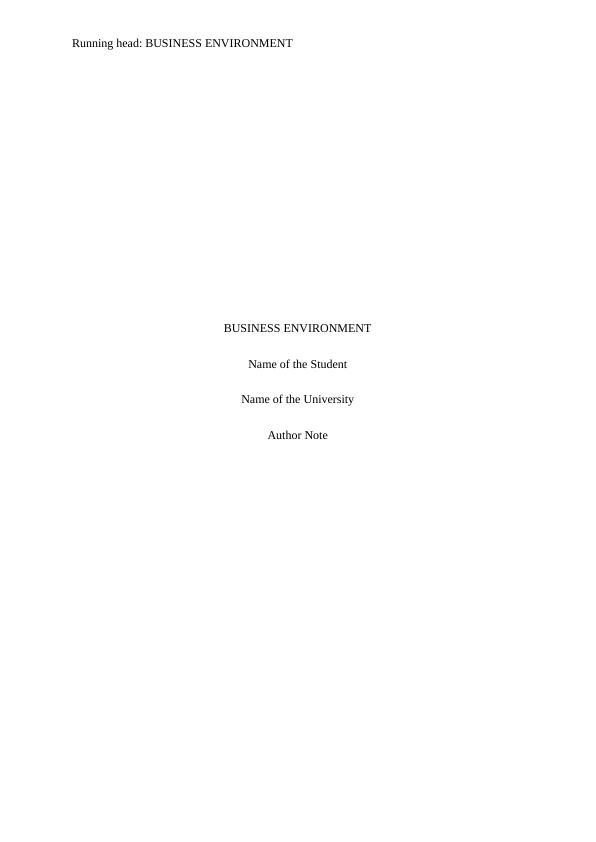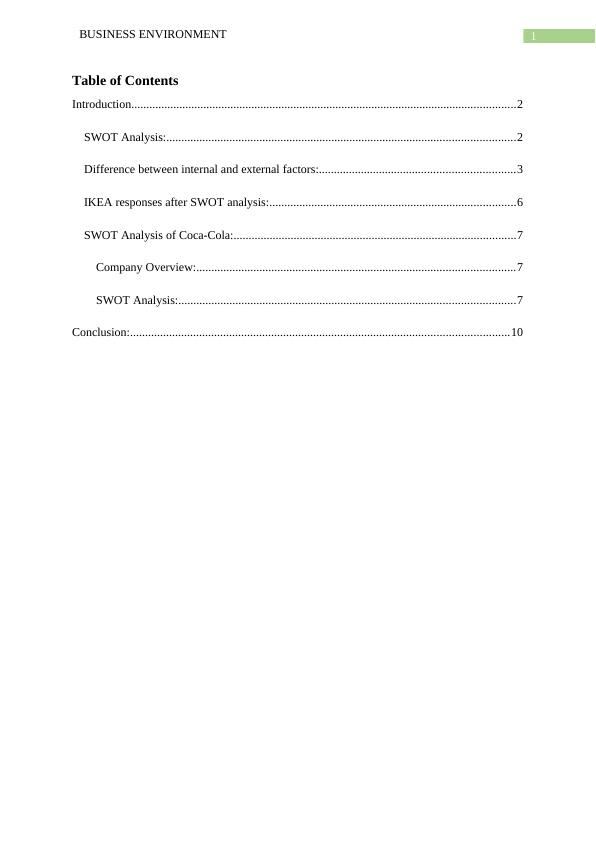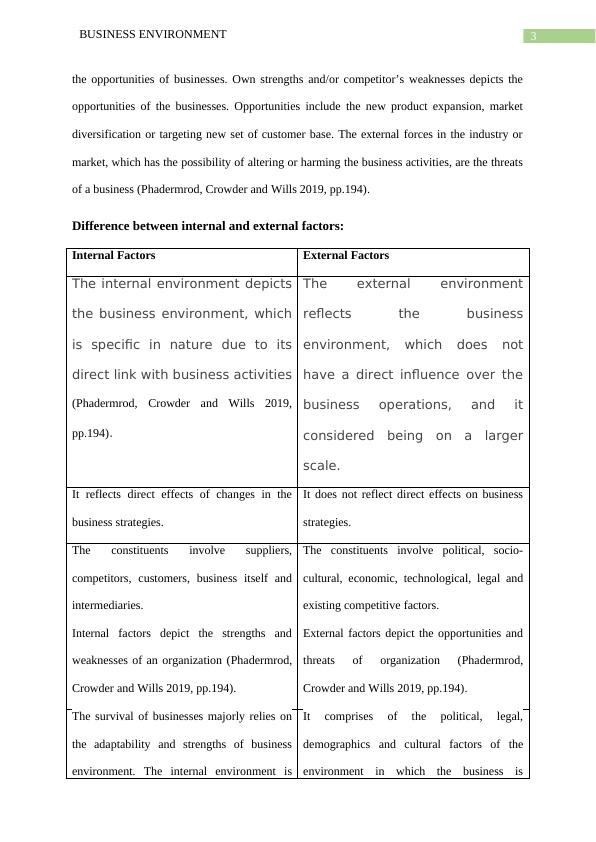Business Environment: SWOT Analysis of IKEA and Coca-Cola
Added on 2023-01-18
13 Pages3242 Words24 Views
Running head: BUSINESS ENVIRONMENT
BUSINESS ENVIRONMENT
Name of the Student
Name of the University
Author Note
BUSINESS ENVIRONMENT
Name of the Student
Name of the University
Author Note

1BUSINESS ENVIRONMENT
Table of Contents
Introduction................................................................................................................................2
SWOT Analysis:....................................................................................................................2
Difference between internal and external factors:.................................................................3
IKEA responses after SWOT analysis:..................................................................................6
SWOT Analysis of Coca-Cola:..............................................................................................7
Company Overview:..........................................................................................................7
SWOT Analysis:................................................................................................................7
Conclusion:..............................................................................................................................10
Table of Contents
Introduction................................................................................................................................2
SWOT Analysis:....................................................................................................................2
Difference between internal and external factors:.................................................................3
IKEA responses after SWOT analysis:..................................................................................6
SWOT Analysis of Coca-Cola:..............................................................................................7
Company Overview:..........................................................................................................7
SWOT Analysis:................................................................................................................7
Conclusion:..............................................................................................................................10

2BUSINESS ENVIRONMENT
Introduction
The sum of internal and external factors, which influences business activities, is
known as business environment. The external environment comprises of the influences,
which reflects impact on the business operations (Phadermrod, Crowder and Wills 2019,
pp.194). The internal environment is comprised of constituents in the organization, which
includes management, existing employees and corporate culture. The purpose of the paper is
to discuss about the concepts of internal and external environment with respect of Ikea.
SWOT Analysis:
The strategic planning approach, which is used for helping an organization for the
identification of strengths, weaknesses, opportunities and threats in regards with the business
competition or/and project planning. The purpose of the SWOT analysis is to depict the
objectives of business ventures followed with the identification of external and internal
factors, which reflects the favorability and challenges in the process of fulfilling the
objectives (Gürel and Tat 2017, pp.51). The analytical framework is used for identifying the
competitive advantages of businesses. It is considered to be one of the crucial tools of
strategic planning.
Strengths are the qualities of an organization, which are possessed internally. It
reflects the success factors of an organization in regards with the existing competition. The
advantages of the organization over competitors or the Unique Selling Point are reflected in
the ‘strengths’ of a SWOT analysis. It may include the quality, the pricing structure or the
valuable customer service experience of an organization. Weaknesses reflect the regions or
departments where organizations need improvement (Phadermrod, Crowder and Wills 2019,
pp.194). The strengths of the competitors can be considered as the source of weaknesses. The
lower market share, poor reputation, low cash reserves and questionable presence in the
market acts as weaknesses in organizations. The areas where the company can excel reflect
Introduction
The sum of internal and external factors, which influences business activities, is
known as business environment. The external environment comprises of the influences,
which reflects impact on the business operations (Phadermrod, Crowder and Wills 2019,
pp.194). The internal environment is comprised of constituents in the organization, which
includes management, existing employees and corporate culture. The purpose of the paper is
to discuss about the concepts of internal and external environment with respect of Ikea.
SWOT Analysis:
The strategic planning approach, which is used for helping an organization for the
identification of strengths, weaknesses, opportunities and threats in regards with the business
competition or/and project planning. The purpose of the SWOT analysis is to depict the
objectives of business ventures followed with the identification of external and internal
factors, which reflects the favorability and challenges in the process of fulfilling the
objectives (Gürel and Tat 2017, pp.51). The analytical framework is used for identifying the
competitive advantages of businesses. It is considered to be one of the crucial tools of
strategic planning.
Strengths are the qualities of an organization, which are possessed internally. It
reflects the success factors of an organization in regards with the existing competition. The
advantages of the organization over competitors or the Unique Selling Point are reflected in
the ‘strengths’ of a SWOT analysis. It may include the quality, the pricing structure or the
valuable customer service experience of an organization. Weaknesses reflect the regions or
departments where organizations need improvement (Phadermrod, Crowder and Wills 2019,
pp.194). The strengths of the competitors can be considered as the source of weaknesses. The
lower market share, poor reputation, low cash reserves and questionable presence in the
market acts as weaknesses in organizations. The areas where the company can excel reflect

3BUSINESS ENVIRONMENT
the opportunities of businesses. Own strengths and/or competitor’s weaknesses depicts the
opportunities of the businesses. Opportunities include the new product expansion, market
diversification or targeting new set of customer base. The external forces in the industry or
market, which has the possibility of altering or harming the business activities, are the threats
of a business (Phadermrod, Crowder and Wills 2019, pp.194).
Difference between internal and external factors:
Internal Factors External Factors
The internal environment depicts
the business environment, which
is specific in nature due to its
direct link with business activities
(Phadermrod, Crowder and Wills 2019,
pp.194).
The external environment
reflects the business
environment, which does not
have a direct influence over the
business operations, and it
considered being on a larger
scale.
It reflects direct effects of changes in the
business strategies.
It does not reflect direct effects on business
strategies.
The constituents involve suppliers,
competitors, customers, business itself and
intermediaries.
Internal factors depict the strengths and
weaknesses of an organization (Phadermrod,
Crowder and Wills 2019, pp.194).
The constituents involve political, socio-
cultural, economic, technological, legal and
existing competitive factors.
External factors depict the opportunities and
threats of organization (Phadermrod,
Crowder and Wills 2019, pp.194).
The survival of businesses majorly relies on
the adaptability and strengths of business
environment. The internal environment is
It comprises of the political, legal,
demographics and cultural factors of the
environment in which the business is
the opportunities of businesses. Own strengths and/or competitor’s weaknesses depicts the
opportunities of the businesses. Opportunities include the new product expansion, market
diversification or targeting new set of customer base. The external forces in the industry or
market, which has the possibility of altering or harming the business activities, are the threats
of a business (Phadermrod, Crowder and Wills 2019, pp.194).
Difference between internal and external factors:
Internal Factors External Factors
The internal environment depicts
the business environment, which
is specific in nature due to its
direct link with business activities
(Phadermrod, Crowder and Wills 2019,
pp.194).
The external environment
reflects the business
environment, which does not
have a direct influence over the
business operations, and it
considered being on a larger
scale.
It reflects direct effects of changes in the
business strategies.
It does not reflect direct effects on business
strategies.
The constituents involve suppliers,
competitors, customers, business itself and
intermediaries.
Internal factors depict the strengths and
weaknesses of an organization (Phadermrod,
Crowder and Wills 2019, pp.194).
The constituents involve political, socio-
cultural, economic, technological, legal and
existing competitive factors.
External factors depict the opportunities and
threats of organization (Phadermrod,
Crowder and Wills 2019, pp.194).
The survival of businesses majorly relies on
the adaptability and strengths of business
environment. The internal environment is
It comprises of the political, legal,
demographics and cultural factors of the
environment in which the business is

End of preview
Want to access all the pages? Upload your documents or become a member.
Related Documents
Hong Kong. Airlines. PESTLE Analysis. Political. Friendlg...
|7
|265
|94
Business in Practicelg...
|2
|380
|92
Business in Practicelg...
|2
|383
|27
Communicationlg...
|4
|374
|92
Community Development Engagement Analysis 2022lg...
|15
|3183
|16
Business in Practicelg...
|1
|269
|87
